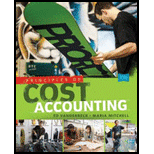
Concept explainers
In all of the exercises involving variances, use “F” and “U” to designate favorable and unfavorable variances, respectively.
E8-1 through E8-5 use the following data:
The standard operating capacity of Tecate Manufacturing Co. is 1,000 units. A detailed study of the manufacturing data relating to the standard production cost of one product revealed the following:
- 1. Two pounds of materials are needed to produce one unit.
- 2. Standard unit cost of materials is $8 per pound.
- 3. It takes one hour of labor to produce one unit.
- 4. Standard labor rate is $10 per hour.
- 5. Standard
overhead (all variable) for this volume is $4,000.
Each case in E8-1 through E8-5 requires the following:
- a. Set up a
standard cost summary showing the standard unit cost. - b. Analyze the variances for materials and labor.
- c. Make journal entries to record the transfer to Work in Process of:
- 1. Materials costs
- 2. Labor costs
- 3. Overhead costs
(When making these entries, include the variances.)
- d. Prepare the
journal entry to record the transfer of costs to the finished goods account.
Standard unit cost;
1,000 units were started and finished.
Case 1: All prices and quantities for the cost elements are standard, except for materials cost, which is $8.50 per pound.
Case 2: All prices and quantities for the cost elements are standard, except that 1,900 lb of materials were used.
a.
Provide a standard cost summary providing the standard unit cost.
Explanation of Solution
Provide a standard cost summary providing the standard unit cost.
| Materials—2 lb @ $8 | $16 |
| Labor—1 hr @ $10 | $10 |
| Factory overhead | $4 |
| Standard unit cost | $30 |
Figure (1)
b.
Examine the variances for materials and labor.
Explanation of Solution
Case 1:
Calculate material price variance:
Working note:
Calculate Actual Quality:
Case 2:
Calculate materials quantity variance:
Note: There are no labor variances in these cases.
c.
Prepare journal entries.
Explanation of Solution
Case 1:
| Date | Account Title and Explanation | Debit ($) | Credit($) |
| Work in Process | $16,000 | ||
| Materials Price Variance | $1,000 | ||
| Materials | $17,000 | ||
| (to record the entry for direct materials cost when the materials are issued into production) |
Table (1)
| Date | Account Title and Explanation | Debit ($) | Credit($) |
| Work in Process | $10,000 | ||
| Payroll | $10,000 | ||
| (to record the entry for direct labor cost) |
Table (2)
| Date | Account Title and Explanation | Debit ($) | Credit($) |
| Work in Process | $4,000 | ||
| Applied Factory overhead | $4,000 | ||
| (to record the entry applying factory overhead to work in process) |
Table (3)
Case 2:
| Date | Account Title and Explanation | Debit ($) | Credit($) |
| Work in Process | $16,000 | ||
| Materials Quantity Variance | $800 | ||
| Materials | $17,000 | ||
| (to record the entry for direct materials cost when the materials are issued into production) |
Table (4)
| Date | Account Title and Explanation | Debit ($) | Credit($) |
| Work in Process | $10,000 | ||
| Payroll | $10,000 | ||
| (to record the entry for direct labor cost) |
Table (5)
| Date | Account Title and Explanation | Debit ($) | Credit($) |
| Work in Process | $4,000 | ||
| Applied Factory overhead | $4,000 | ||
| (to record the entry applying factory overhead to work in process) |
Table (6)
d.
Prepare the journal entry.
Explanation of Solution
Case 1 and case 2:
| Date | Account Title and Explanation | Debit ($) | Credit($) |
| Finished Goods | $30,000 | ||
| Work in process | $30,000 | ||
| (to record the entry for finished goods at standard cost) |
Table (7)
Want to see more full solutions like this?
Chapter 8 Solutions
Principles of Cost Accounting
Additional Business Textbook Solutions
Engineering Economy (17th Edition)
Principles of Operations Management: Sustainability and Supply Chain Management (10th Edition)
Gitman: Principl Manageri Finance_15 (15th Edition) (What's New in Finance)
PRIN.OF CORPORATE FINANCE
Foundations of Financial Management
Essentials of Corporate Finance (Mcgraw-hill/Irwin Series in Finance, Insurance, and Real Estate)
- I need the correct answer to this general accounting problem using the standard accounting approach.arrow_forwardI need the correct answer to this general accounting problem using the standard accounting approach.arrow_forwardI am searching for the accurate solution to this general accounting problem with the right approach.arrow_forward
- I am trying to find the accurate solution to this general accounting problem with the correct explanation.arrow_forwardI am searching for the accurate solution to this general accounting problem with the right approach.arrow_forwardPlease provide the correct answer to this general accounting problem using valid calculations.arrow_forward
- Please provide the correct answer to this general accounting problem using valid calculations.arrow_forwardPlease explain the solution to this general accounting problem using the correct accounting principles.arrow_forwardCan you solve this general accounting problem using appropriate accounting principles?arrow_forward
 Principles of Cost AccountingAccountingISBN:9781305087408Author:Edward J. Vanderbeck, Maria R. MitchellPublisher:Cengage Learning
Principles of Cost AccountingAccountingISBN:9781305087408Author:Edward J. Vanderbeck, Maria R. MitchellPublisher:Cengage Learning Managerial Accounting: The Cornerstone of Busines...AccountingISBN:9781337115773Author:Maryanne M. Mowen, Don R. Hansen, Dan L. HeitgerPublisher:Cengage LearningPrinciples of Accounting Volume 2AccountingISBN:9781947172609Author:OpenStaxPublisher:OpenStax College
Managerial Accounting: The Cornerstone of Busines...AccountingISBN:9781337115773Author:Maryanne M. Mowen, Don R. Hansen, Dan L. HeitgerPublisher:Cengage LearningPrinciples of Accounting Volume 2AccountingISBN:9781947172609Author:OpenStaxPublisher:OpenStax College


